Motives In The Mountains (Part 1)
Posted by Jeremy Windsor on Jul 10, 2020
I have often wondered what it is that motivates us to take to the mountains and do what most wouldn't even dream of trying! Soloing rock routes, struggling up long winter climbs or embarking upon high altitude adventures. We don't have to, but we do! In this post Carlo Macri explores his motivations and the risk taking behaviour that this lead to. Afterwards we asked Jim Duff, mountaineer, GP and founder of International Porter Protection Group and psychiatrist Tony Page for their thoughts. First, here's Carlo...
"It all started with "Training For The New Alpinism". We had started using cheap interseason flights to become weekend warriors. We got used to short time windows, approaching from the valley at night, all after a day's work at the office. I couldn’t choose when to go based on conditions but rather on my flights. We had a few close shaves, but always had good stories to tell. I had lost my first partner to a gnarly sunburn and him coming to terms with the fact that he was afraid of heights, which we found out was one of the most difficult phobias to combine with mountain sports.

Training For The New Alpinism by Steve House and Scott Johnston. A readable and highly instructive manual for those wanting to develop their physical fitness for activities in the mountains. At the outset it should be said that the authors do not encourage risk taking behaviour and go to great lengths to encourage readers to make safe decisions in the outdoors
My new partner was more training orientated and gave me his copy to read. I wanted to become an endurance machine propelled by the vapours of exhaustion. To go longer, harder and higher with less gear than others. To compress 2 day routes in one push, 3 day routes in 36 hours, no sleep. I fantasised about having to lead bold mixed pitches on choss and thin ice with a strengthening sun and non-existent pro to get us out of harm's way (‘difficult climbing’ garble). Objective dangers turned me on: a threatening serac, softening afternoon snow, an incoming storm, increasing avalanche risk. On returning to the valley, I dreamt of kissing the pavement and being thankful I was alive. And then a single line, a few chapters in, started rolling a ball that hasn’t yet run its course. “What are your real motivations?”. The big why, with a capital ‘W’. I blurrily recall Steve House’s reason being something along lines of having low self esteem as a teenager. He said it was important to be honest with yourself. It would improve my training and performance in the mountains and that’s exactly what I wanted. So what were they? I started to think about my life before the mountains. Timeline-wise I guess it started after my then girlfriend, ended things. When it became apparent that love couldn’t conquer all, not the oceans between continents, not different love languages, not depression and anxiety. When my world was spun off its axis. Well that just explains that I had more time for the mountains, something that she wasn’t particularly keen on. I reported back to my new climbing partner about my findings and he said he also got into mountaineering, after a breakup, a bad one. That was a pretty big coincidence.
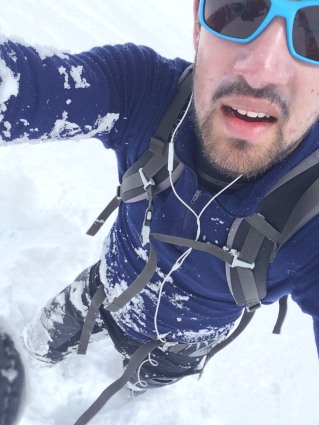
Carlo in deep powder snow
So while the proverbial climber’s rat was gnawing at me to train harder, go deeper into the mountains and choose more committing routes, another rat appeared on the scene! This rat wanted to know what was with this connection between break ups and my new hobby. If breaking up was really linked to the mountains, the mountains would be full of sad, lonely people wandering around. Every sad romantic ballad would end with a verse about heading into the hills. But all I saw was strong stoic mountaineers willing to take head-on the sizeable inherent risks involved, to make a life worth living, where you feel like you are living, much like myself. Or so I thought. As I explored the limits of my exhaustion, as I went through partners and as the stories got more enthralling, to the point where colleagues privately started to tell me they were concerned, the new rat was collecting important information on the older rat. I can’t quite recall when or how, but that darn rat ratted out his older brother. It started to all make sense.
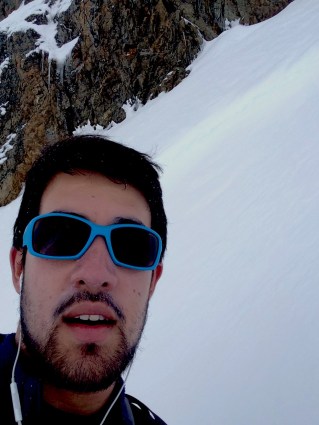
Recovering after triggering a slab avalanche - the 15-20cm crown line can be seen at the top of the image
I looked back at my relationship to risk. It wasn’t good. Like some food you saved in the furthest reaches of your fridge 3 months ago, it all looked ugly and reckless. But realising you have a problem is only the first step. Changing how you plan trips was tough but ought to be do-able, feeling stoke during and satisfaction after a climb seemed impossible to change. I didn’t stop going to the mountains, the opposite happened, I moved to them. So I continued, having to ask myself what are my genuine desires and what is a result from trauma. Am I taking risk in the mountains as only an external means of proving my worth? Can I only feel alive when my life’s under threat? How much do I have to turn my back on a love which almost ended me? Back then, the veteran climbers in Denmark smelt it on me. I smell it on potential climbing partners. Chamonix is reeking with it. For my 30th birthday, my 26 year old self took the reins and perhaps unsurprisingly, I broke the snow cover on a glacier and fell to my armpits into a crevasse, unroped, alone after summiting Mont Blanc. A few days later and I would have gone straight through.
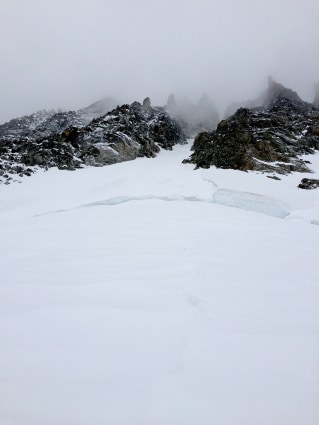
A photo taken before a solo climb of the couloir - the bergschrund proved to be a much tougher obstacle than expected
I’m not going to bother to say don’t project my story on mountaineers who take great risks; that they are all just traumatized, running away from something or simply trying to prove themselves. Allow them their own journey. A journey in which we are our own master and slave simultaneously."
Thanks Carlo for such an honest and thoughtful account. Here is Jim Duff, veteran of exploratory expeditions to Everest, K2, Changbang and many other Himalayan mountains to share his thoughts...
Phew, where to start. It's a book length project!
What is this young fella saying? That he worries he has a death wish? That he fears he climbs to deal with a broken heart? That fear is the drug that makes him feel alive? That he might have died in that crevasse? That his colleagues are concerned about his behaviour?
Here are some suggestive signs and symptoms of toxicity, apart from self doubt, depression and anxiety all of which are natural enough, there is the history of multiple partners, soloing and masochism. All the latter suggestive of trouble, somewhat ameliorated by his articulate confession.
Of course he should worry about all those things, it's all part of growing up. He's only going to come to terms with these questions a) if he lives long enough, b) when he's fallen in love a few more times and c) if he is lucky enough to get accepted by more mature climbers. He needs to be aware that toxic motivation resulting in selfishness, pushiness etc is soon exposed in the crucible. Meantime at least the hills are keeping him from running amok in other less palatable directions.
I've climbed and expeditioned with some seriously brilliant people at the top of the game, all of them have probably been through some of the doubts and torment of the writer when they were young. Some have even written about it. How have they turned out? With a few exceptions they survived and, generalising, they were intelligent, thoughtful, generous, self contained and stable. Usually there was a wicked sense of humour, that vital ingredient for team spirit, the craic, the banter. They didn't suffer fools gladly but were not unnecessarily cruel. A couple of them had troubled backgrounds yet managed to save us, their companions, from any serious discomfort, other than surviving their aloofness.
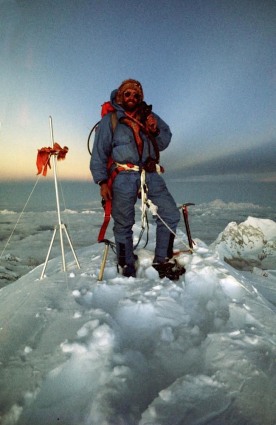
Jim, together with Dr Charlie Clarke, were the doctors on the 1975 British Mt Everest South West Face Expedition. Doug Scott (pictured) and Dougal Haston were the first to climb what proved to be one of the most challenging routes on the mountain. A short film about the expedition can be found here.
None of them had discernible personality disorders or death wishes. But here they were constantly and repeatedly putting themselves at high risk of death (through mountaineering plus, I guess, serious trad or solo rock climbing) which must, on all rational criteria, be judged insane.
I did have to help deal with grief, both at loss of life but also serious injury. I'd say that there was quite a bit of time between expeditions talking through what were certainly symptoms of Post Traumatic Stress Disorder. Also one could become involved in what was really counselling related to life back down on the ground. On one or two occasions a 'doctor's note' was necessary to cover a failure of nerve (a totally rational response to threats involved, ie sanity prevailing) or disappointment.
All this begs the question what motivates mountaineers? Does that motivation vary with age, education, family, genetics, era (the Victorians) or nationality (the Poles!). Of course it does. This short list of book titles give us any ideas - Psychovertical, The Games Climbers Play, Climbing Free, A Climbers Guide To Love and Gravity, No Picnic On Mount Kenya, Savage Arena, Mountain Of My Fear and Deep Play.
It's my proposition that there is a common quality that underlies the endless variety of motivations that mountaineers come up with for their 'insane' behaviour. Something that is lies beneath Mallory's dismissive 'because it's there'.
Till next time, go canny!"
Thanks Jim. Here's retired psychiatrist Tony Page with his thoughts...
"Interesting text! Some thoughts: I'm not sure one should generalise about risk-taking behaviour. Psychiatry probably doesn't have much to usefully say about it (emphasis on the usefully). Psychiatrists are of course preoccupied with risk assessment - worrying that a patient might harm themselves or others - but always in the context of a mental disorder. (Inquiries follow, usually finding issues with communication between professionals and then apportioning blame - or so it seems!)
Epidemiology claims to tell us that adolescent males are the group who take the most risks. But not always - apparently women are more likely to take social risks, wearing more way-out clothes and being more likely to move to a new city. Then again, this might be true for women in Los Angeles but I doubt the same would be true for women in, say, Lahore. Cultural factors will have a major influence on behaviour. Dipping my toes into the academic literature it seems that along with social psychology, behavioural economics is now a maior player in studies of risk. The problem is, the two disciplines have different definitions of risk. Behavioural genetics is in there too. I've no idea what the behavioural geneticists' definition is but they have concluded, bless 'em, that there isn't a single gene for risk taking. What a surprise! Instead, they believe that many genes contribute - stand by for papers calculating the percentage variance of particular genes contributing to risk taking. Of course, even if this approach was thought to make sense it is unlikely to ever be of practical use to anybody.
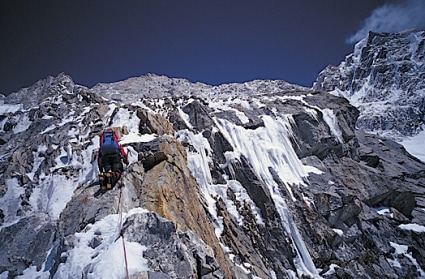
"In August 2004 Bruce Miller and Steve House climbed to 7559m on Nanga Parbat's Rupal Face before Bruce decided they had to descend because he thought Steve was pushing himself too far. Steve's emotional state during that climb was introverted and fatalistic. His awareness of risk and his reaction to discomfort, hard work, danger and cold were numbed ... His friends were worried; Barry Blanchard wrote to him saying that he had, "become a creature of the wall" and advised that he back off for a while." (Photo: Steve House)
Probably better to think idiographically rather than nomothetically. What is the negative outcome, for whom and in what circumstances? So far as mountaineering is concerned, I'm sure that many factors in addition to relationship break-ups can have a persisting effect on decision-making. If there is a repeated pattern, the first thing is recognising that this is the case. In Steve House's "Training For The New Alpinism" he mentions how older, more experienced climbers wrote to him, took him aside and even forced him to retreat from near the top of Nanga Parbat because they thought he had become numbed to danger and had been pushing himself too hard. If experienced colleagues are saying this to you, best to take note.
House writes about self-exploration, though doesn't really expand on this very much. But being aware, or having it pointed out to you, seems to me to be a first step in examining what it is you are up to, and why. Maybe this, and discussions with those older colleagues will be enough to enable a change in behaviour. I'd resist pathologising it, though, and definitely wouldn't want a future DSM-6 or ICD 12 to include diagnostic criteria for Abberant Mountaineering Judgement Disorder!
That said, if it continued to be a problem then seeking help wouldn't be out of order. However, don't expect the NHS to be interested. Probably person-centred counselling would be my recommendation for this kind of issue. Even better if the counsellor is a mountaineer!"
Thanks Tony and Jim for contributing to this post!
Motives in the Mountains (Part 2) can be found here.
Comments
Leave a comment.
Leave a comment.



 )
)